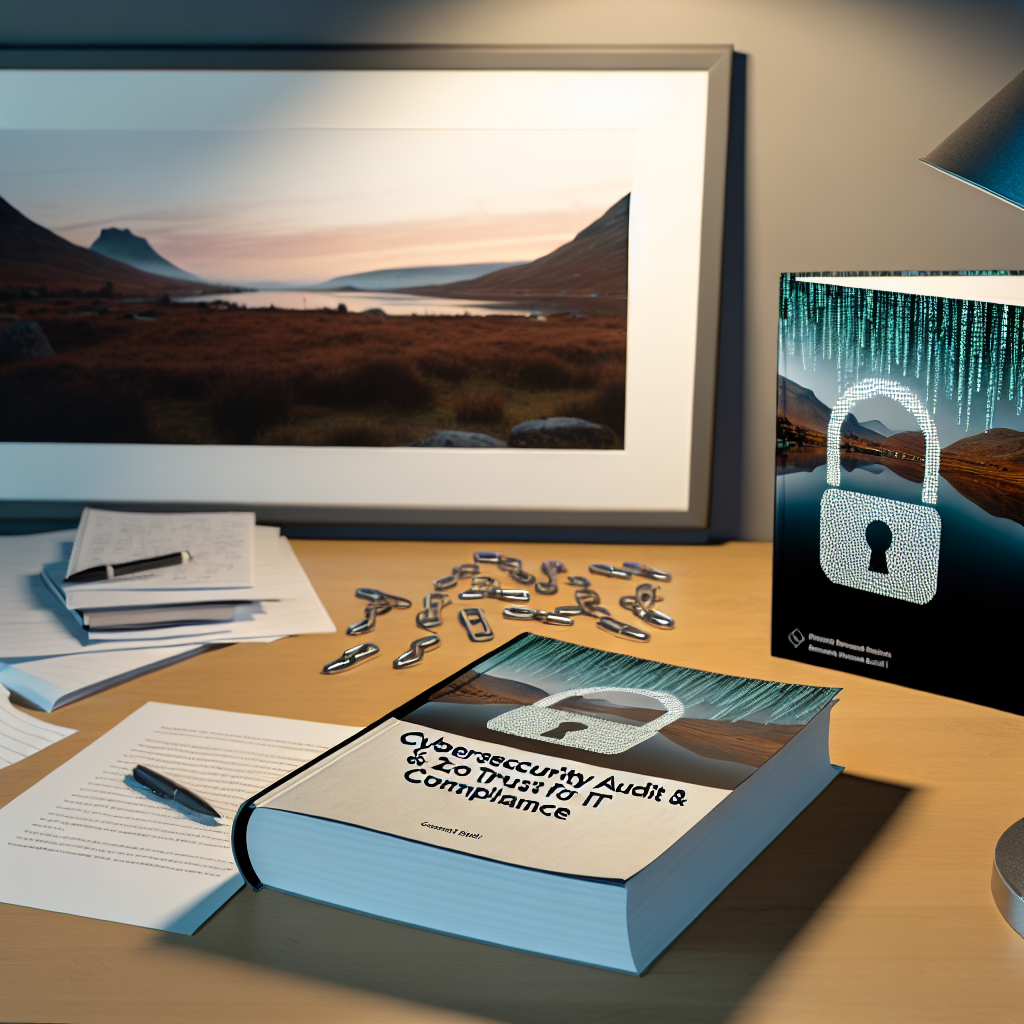Understanding Zero Trust: A Modern Approach to Cybersecurity Audit
In the rapidly evolving landscape of digital technology, cybersecurity has become a paramount concern for organizations worldwide. As cyber threats grow in sophistication and frequency, traditional security measures are often insufficient to protect sensitive data and critical infrastructure. This has led to the emergence of the Zero Trust model, a modern approach to cybersecurity that fundamentally changes how organizations conduct security audits and implement IT strategies.
Zero Trust is based on the principle of “never trust, always verify.” Unlike traditional security models that rely on perimeter defenses, Zero Trust assumes that threats can originate both outside and inside the network. Therefore, it requires strict identity verification for every person and device attempting to access resources on a private network, regardless of whether they are inside or outside the network perimeter. This approach significantly enhances security by minimizing the risk of unauthorized access and data breaches.
Incorporating Zero Trust into cybersecurity audits involves a comprehensive evaluation of an organization’s security posture. Auditors must assess the effectiveness of identity and access management (IAM) systems, ensuring that they are robust enough to handle the demands of a Zero Trust environment. This includes verifying that multi-factor authentication (MFA) is in place and that access controls are granular and dynamic, adapting to the context of each access request. Additionally, auditors must evaluate the organization’s ability to monitor and log all network activity, as continuous monitoring is a critical component of the Zero Trust model.
Transitioning to a Zero Trust architecture also requires a shift in IT strategies. Organizations must adopt a more holistic approach to security, integrating Zero Trust principles into every aspect of their IT infrastructure. This involves segmenting networks to limit lateral movement by potential attackers and implementing micro-segmentation to create isolated environments for sensitive data and applications. Furthermore, organizations must ensure that their security policies are consistently enforced across all devices and platforms, including cloud services and mobile devices.
The implementation of Zero Trust is not without its challenges. It requires significant investment in technology and resources, as well as a cultural shift within the organization. Employees must be educated about the importance of cybersecurity and trained to recognize potential threats. Moreover, organizations must be prepared to manage the increased complexity that comes with a Zero Trust architecture, as it involves coordinating multiple security technologies and processes.
Despite these challenges, the benefits of adopting a Zero Trust model are substantial. By reducing the attack surface and enhancing visibility into network activity, organizations can better protect themselves against cyber threats. Additionally, Zero Trust can improve compliance with regulatory requirements, as it provides a clear framework for managing access to sensitive data.
In conclusion, the Zero Trust model represents a significant advancement in cybersecurity strategy, offering a more effective way to protect against modern threats. By incorporating Zero Trust principles into cybersecurity audits and IT strategies, organizations can enhance their security posture and better safeguard their digital assets. As cyber threats continue to evolve, embracing a Zero Trust approach will be essential for organizations seeking to maintain robust security in an increasingly complex digital world.
Enhancing Endpoint Protection: Key Strategies for IT Compliance
In the rapidly evolving landscape of cybersecurity, enhancing endpoint protection has become a critical component of IT compliance strategies. As organizations increasingly rely on a diverse array of devices to conduct business, the need to secure these endpoints has never been more pressing. The proliferation of mobile devices, laptops, and IoT gadgets has expanded the attack surface, making it imperative for businesses to adopt robust endpoint protection measures. To achieve this, organizations must integrate comprehensive strategies that not only safeguard their endpoints but also ensure compliance with regulatory standards.
One of the foundational strategies for enhancing endpoint protection is the implementation of advanced threat detection and response systems. These systems are designed to identify and mitigate threats in real-time, providing a proactive approach to cybersecurity. By leveraging machine learning and artificial intelligence, these systems can analyze vast amounts of data to detect anomalies and potential threats before they can cause significant harm. This proactive stance is crucial for maintaining IT compliance, as it demonstrates an organization’s commitment to protecting sensitive data and adhering to regulatory requirements.
In addition to advanced threat detection, organizations must also prioritize the regular updating and patching of software and operating systems. Cybercriminals often exploit vulnerabilities in outdated software to gain unauthorized access to systems. By ensuring that all software is up-to-date, organizations can close potential entry points for attackers. This practice not only enhances endpoint security but also aligns with compliance mandates that require organizations to maintain secure systems.
Furthermore, implementing robust access controls is essential for protecting endpoints. By adopting a zero-trust model, organizations can ensure that only authorized users have access to sensitive data and systems. This approach requires continuous verification of user identities and limits access based on the principle of least privilege. By doing so, organizations can minimize the risk of insider threats and unauthorized access, thereby strengthening their compliance posture.
Another critical aspect of endpoint protection is the use of encryption to safeguard data both at rest and in transit. Encryption ensures that even if data is intercepted or accessed by unauthorized individuals, it remains unreadable and secure. This is particularly important for organizations that handle sensitive information, as it not only protects the data but also helps meet compliance requirements related to data protection and privacy.
Moreover, organizations should invest in comprehensive endpoint management solutions that provide visibility and control over all devices connected to the network. These solutions enable IT teams to monitor device health, enforce security policies, and respond swiftly to incidents. By maintaining a clear overview of all endpoints, organizations can ensure that they remain compliant with industry standards and regulations.
Finally, fostering a culture of cybersecurity awareness among employees is vital for enhancing endpoint protection. Regular training sessions and awareness programs can educate employees about the latest threats and best practices for safeguarding their devices. By empowering employees with knowledge, organizations can reduce the likelihood of human error, which is often a significant factor in security breaches.
In conclusion, enhancing endpoint protection is a multifaceted endeavor that requires a combination of advanced technologies, strategic policies, and employee engagement. By adopting these key strategies, organizations can not only protect their endpoints from evolving threats but also ensure compliance with the ever-changing landscape of IT regulations. As cybersecurity challenges continue to grow, a proactive and comprehensive approach to endpoint protection will remain a cornerstone of effective IT compliance strategies.
Firewall Setup Best Practices: Strengthening Your Network Against Intrusion
In the ever-evolving landscape of digital threats, the importance of a robust firewall setup cannot be overstated. As organizations increasingly rely on digital infrastructure, the need to protect sensitive data from unauthorized access becomes paramount. A well-configured firewall serves as the first line of defense against cyber intrusions, acting as a barrier between trusted internal networks and untrusted external networks. To ensure optimal protection, it is essential to adhere to best practices in firewall setup, which not only fortify the network but also enhance overall cybersecurity posture.
To begin with, understanding the specific needs of your organization is crucial. This involves conducting a thorough risk assessment to identify potential vulnerabilities and the types of threats most likely to target your network. By doing so, you can tailor your firewall configuration to address these specific risks, thereby maximizing its effectiveness. Moreover, it is important to choose a firewall solution that aligns with your organization’s size, complexity, and security requirements. Whether opting for a hardware-based firewall, a software solution, or a combination of both, the chosen system should be scalable and capable of adapting to future technological advancements.
Once the appropriate firewall solution is in place, the next step is to establish a comprehensive security policy. This policy should define the rules and criteria for allowing or denying network traffic, based on factors such as IP addresses, protocols, and ports. Implementing a default-deny policy, where all traffic is blocked unless explicitly permitted, is a widely recommended practice. This approach minimizes the risk of unauthorized access by ensuring that only necessary and verified traffic is allowed through the firewall.
In addition to setting up a robust security policy, regular updates and patches are vital to maintaining firewall integrity. Cyber threats are constantly evolving, and outdated firewall software can become a significant vulnerability. Therefore, it is imperative to keep the firewall system up-to-date with the latest security patches and firmware updates. This proactive approach not only addresses known vulnerabilities but also enhances the firewall’s ability to detect and mitigate new threats.
Furthermore, monitoring and logging network traffic is an essential component of effective firewall management. By continuously analyzing traffic patterns and maintaining detailed logs, organizations can identify suspicious activities and respond promptly to potential security incidents. This real-time monitoring enables IT teams to detect anomalies, investigate breaches, and implement corrective measures swiftly, thereby minimizing potential damage.
Another critical aspect of firewall setup is the segmentation of networks. By dividing the network into smaller, isolated segments, organizations can limit the spread of malware and contain potential breaches. This practice, known as network segmentation, ensures that even if one segment is compromised, the rest of the network remains secure. Implementing virtual local area networks (VLANs) and demilitarized zones (DMZs) are effective strategies for achieving network segmentation and enhancing overall security.
Finally, regular audits and reviews of firewall configurations are essential to ensure continued effectiveness. As business needs and technological landscapes change, firewall settings may require adjustments to align with new security requirements. Periodic audits help identify configuration errors, redundant rules, and potential security gaps, allowing organizations to refine their firewall setup and maintain a robust defense against cyber threats.
In conclusion, a well-configured firewall is a cornerstone of modern IT strategies, providing essential protection against cyber intrusions. By understanding organizational needs, establishing comprehensive security policies, keeping systems updated, monitoring traffic, segmenting networks, and conducting regular audits, organizations can significantly strengthen their network defenses. As cyber threats continue to evolve, adhering to these best practices in firewall setup will ensure that your network remains resilient and secure.
Advanced Threat Detection: Integrating Modern IT Strategies for Cybersecurity
In the rapidly evolving landscape of digital technology, the importance of robust cybersecurity measures cannot be overstated. As organizations increasingly rely on digital infrastructures, the threat landscape has expanded, necessitating advanced threat detection mechanisms. Integrating modern IT strategies into cybersecurity frameworks is essential for safeguarding sensitive information and maintaining operational integrity. A pivotal component of this integration is the cybersecurity audit, which serves as a comprehensive evaluation of an organization’s security posture.
A cybersecurity audit is a systematic examination of an organization’s information systems, policies, and procedures. It aims to identify vulnerabilities, assess compliance with regulatory standards, and recommend improvements. By conducting regular audits, organizations can proactively address potential security gaps before they are exploited by malicious actors. This proactive approach is crucial in an era where cyber threats are becoming more sophisticated and frequent.
Modern IT strategies play a significant role in enhancing the effectiveness of cybersecurity audits. One such strategy is the adoption of artificial intelligence (AI) and machine learning (ML) technologies. These technologies enable the automation of threat detection processes, allowing for real-time analysis of vast amounts of data. By leveraging AI and ML, organizations can identify patterns and anomalies that may indicate a security breach, thereby facilitating quicker response times and minimizing potential damage.
Furthermore, the integration of cloud computing into cybersecurity strategies has revolutionized the way organizations manage and protect their data. Cloud-based solutions offer scalability, flexibility, and cost-effectiveness, making them an attractive option for businesses of all sizes. However, the transition to cloud environments also introduces new security challenges. Therefore, it is imperative for organizations to implement robust cloud security measures, such as encryption, access controls, and continuous monitoring, to ensure the integrity and confidentiality of their data.
In addition to technological advancements, modern IT strategies emphasize the importance of a holistic approach to cybersecurity. This involves fostering a culture of security awareness within the organization. Employees are often the first line of defense against cyber threats, and their actions can significantly impact the overall security posture. Regular training and awareness programs can equip employees with the knowledge and skills needed to recognize and respond to potential threats, thereby reducing the risk of human error.
Moreover, collaboration and information sharing among organizations are critical components of modern cybersecurity strategies. By participating in industry forums and threat intelligence networks, organizations can gain valuable insights into emerging threats and best practices. This collaborative approach not only enhances individual security measures but also contributes to the collective resilience of the digital ecosystem.
In conclusion, the integration of modern IT strategies into cybersecurity frameworks is essential for effective threat detection and mitigation. Cybersecurity audits provide a foundation for identifying vulnerabilities and ensuring compliance, while technologies such as AI, ML, and cloud computing offer advanced tools for protecting digital assets. A holistic approach that includes employee training and inter-organizational collaboration further strengthens an organization’s security posture. As cyber threats continue to evolve, it is imperative for organizations to remain vigilant and adaptive, leveraging modern IT strategies to safeguard their digital infrastructures and maintain trust in an increasingly interconnected world.
Conducting a Comprehensive Cybersecurity Audit: Ensuring Robust IT Compliance
In today’s rapidly evolving digital landscape, the importance of conducting a comprehensive cybersecurity audit cannot be overstated. As organizations increasingly rely on technology to drive their operations, the need to ensure robust IT compliance has become paramount. A cybersecurity audit serves as a critical tool in this endeavor, providing a systematic evaluation of an organization’s information systems, policies, and procedures. By identifying vulnerabilities and assessing the effectiveness of existing security measures, a cybersecurity audit helps organizations safeguard their digital assets and maintain the trust of their stakeholders.
To begin with, a cybersecurity audit involves a thorough examination of an organization’s IT infrastructure. This includes evaluating hardware, software, networks, and data management practices. By scrutinizing these components, auditors can identify potential weaknesses that could be exploited by cybercriminals. Moreover, the audit process involves reviewing access controls and authentication mechanisms to ensure that only authorized personnel have access to sensitive information. This step is crucial in preventing unauthorized access and data breaches, which can have devastating consequences for an organization.
In addition to assessing technical aspects, a comprehensive cybersecurity audit also examines an organization’s policies and procedures. This involves reviewing the effectiveness of security policies, incident response plans, and employee training programs. By doing so, auditors can determine whether an organization is adequately prepared to respond to cyber threats and whether its employees are equipped with the necessary knowledge to recognize and mitigate potential risks. Furthermore, the audit process helps identify gaps in compliance with industry standards and regulations, such as the General Data Protection Regulation (GDPR) or the Health Insurance Portability and Accountability Act (HIPAA). Ensuring compliance with these regulations is not only a legal obligation but also a critical component of maintaining customer trust and protecting an organization’s reputation.
As organizations strive to enhance their cybersecurity posture, modern IT strategies play a pivotal role in supporting these efforts. One such strategy is the adoption of a risk-based approach to cybersecurity. This involves prioritizing security measures based on the potential impact and likelihood of various threats. By focusing resources on the most significant risks, organizations can optimize their security investments and enhance their overall resilience. Additionally, the integration of advanced technologies, such as artificial intelligence and machine learning, into cybersecurity practices can significantly improve threat detection and response capabilities. These technologies enable organizations to analyze vast amounts of data in real-time, identify patterns indicative of cyber threats, and respond swiftly to mitigate potential damage.
Moreover, the shift towards cloud computing and remote work has necessitated a reevaluation of traditional cybersecurity strategies. Organizations must now consider the security implications of distributed work environments and ensure that their cybersecurity measures extend beyond the confines of their physical offices. This includes implementing robust encryption protocols, securing remote access points, and continuously monitoring network activity for suspicious behavior. By adapting to these changes, organizations can maintain a strong security posture in an increasingly decentralized digital world.
In conclusion, conducting a comprehensive cybersecurity audit is an essential step in ensuring robust IT compliance and safeguarding an organization’s digital assets. By systematically evaluating technical infrastructure, policies, and procedures, organizations can identify vulnerabilities and enhance their cybersecurity posture. Furthermore, the adoption of modern IT strategies, such as risk-based approaches and advanced technologies, can significantly bolster an organization’s ability to detect and respond to cyber threats. As the digital landscape continues to evolve, organizations must remain vigilant and proactive in their cybersecurity efforts to protect their assets and maintain the trust of their stakeholders.
Enhance your organization’s security posture with our expert insights on cybersecurity audits and modern IT strategies. Discover more by visiting our website today!











